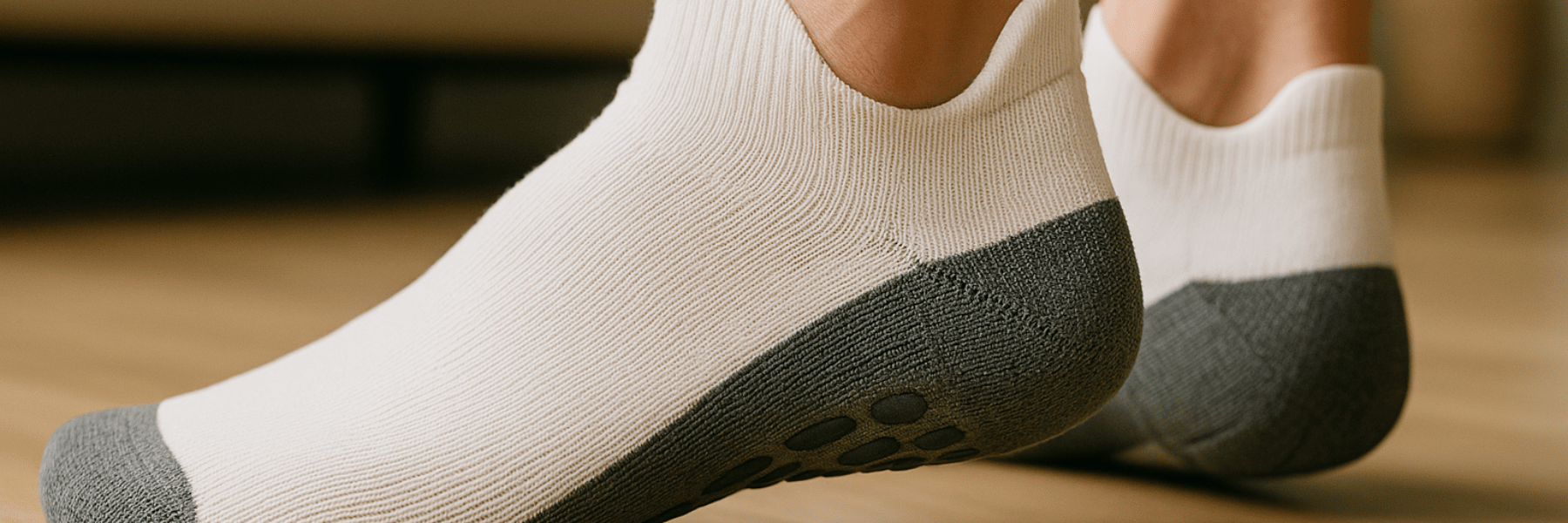Choose high-quality socks made from materials like merino wool or bamboo, with at least 10% elastane for better stretch. Look for designs featuring a hemispherical heel and distinct left and right foot shaping to guarantee a snug, comfortable fit without slippage. Opt for sock heights that match your sneakers, and make sure the calf region provides adequate snugness. Replace worn-out socks regularly for peak performance. A few additional accessories and tips can help your socks stay firmly in place.
Choose High-Quality Socks With Proper Fit
One of the easiest ways to keep socks from slipping in your sneakers is investing in high-quality socks made from durable, comfortable materials like bamboo or merino wool.
Choose socks designed specifically for a proper fit, with reinforced heels and toes that provide extra support and grip. Socks featuring elastic bands or spandex fibers offer stretch and flexibility, giving your feet a secure fit without restricting movement.
High-quality socks prevent slippage by retaining their shape, even after multiple wears and washes. Always select socks that match your foot size closely rather than wide-ranging sizes, as a precise fit reduces unwanted movement.
Regularly rotating and replacing worn-out socks guarantees they maintain elasticity and continue offering the snug, secure fit necessary for preventing annoying slippage.
Opt for Socks Featuring a Hemispherical Heel Design
Slipping socks can quickly ruin your comfort and performance, but opting for socks featuring a hemispherical heel design can effectively solve this issue.
This innovative design conforms precisely to your heel's natural shape, enabling socks to fit snugly and prevent slipping during movement. By maintaining close contact with your foot, the hemispherical heel design eliminates gaps that cause bunching and discomfort.
Many of these socks include elastic bands or reinforced stitching around the heel area, enhancing grip and ensuring stability inside your sneakers. Additionally, the secure fit offered by hemispherical heel socks helps reduce friction, lowering the risk of blisters and irritation.
Choosing socks with this strategic design optimizes your overall foot comfort, keeping you comfortable and confident during every activity.
Select Socks With Differentiated Left and Right Foot Options
When choosing socks, look for options specifically designed with differentiated left and right foot shapes, as these offer a more precise fit and better conform to your unique anatomy.
By selecting socks with differentiated left and right foot options, you guarantee an anatomical fit that matches each foot's individual contours. This tailored design provides targeted support, allowing socks to fit snugly without excess fabric.
As a result, you greatly reduce slippage and prevent them from sliding inside your sneakers. Differentiated designs also feature strategic cushioning and elastic zones, enhancing comfort and grip.
Prioritize Socks With a High Elastane Content
Along with selecting socks tailored to your left and right foot, prioritize options with a high elastane content.
Socks with high elastane content offer superior stretch, ensuring a snug fit that will greatly reduce slippage inside your sneakers. Elastane provides exceptional elasticity, allowing socks to conform closely to your foot, enhancing support and comfort during movement.
By choosing socks with at least 10% elastane, you'll avoid socks slipping and bunching, since lower-elasticity fabrics lose their shape quickly. Blended materials—like cotton or wool combined with elastane—offer moisture-wicking benefits, combining comfort and style while ensuring that your socks stay in place during activity.
Regularly check elastane percentages when purchasing socks; this helps you select durable options that maintain their shape and grip for long-lasting wear.
Ensure the Right Sock Height and Calf Snugness
Choosing socks with the correct height and a snug calf fit helps keep them firmly in place during activity.
Match your sock height to your sneakers; for low-cut shoes, select crew or ankle socks to provide enough coverage and create a barrier against slipping. Proper sock height guarantees a secure fit by engaging with your shoe's collar.
Additionally, calf snugness is essential—opt for socks featuring elastic bands or compression elements around the calf to maintain a comfortable fit and prevent slipping.
Look for socks with deeper heel pockets, which conform better to the foot's shape, further enhancing stability.
Regularly check your sock's snug fit around the calf and adjust tightness as needed to maintain calf snugness and guarantee consistent comfort and support.
Utilize Anti-Slip Footwear Accessories
Sometimes, even high-quality socks need extra support to stay perfectly in place. Utilizing anti-slip footwear accessories can greatly reduce sock slippage and improve overall comfort.
Insert heel grips or pads into your sneakers to deliver cushioning and stability, which helps prevent socks from sliding down as you move. Silicone pads or adhesive strips applied inside your shoe provide extra grip, holding socks securely in position during various activities.
Additionally, insoles or arch supports enhance fit by stabilizing your foot, minimizing unnecessary movement that often leads to sock bunching. Gel or foam inserts also offer targeted cushioning in critical areas, further decreasing sock movement.
Regularly Maintain and Replace Worn-Out Socks
One simple yet essential step to prevent socks from slipping is regularly inspecting them for signs of wear.
Check frequently for stretched elastic, thinning fabric, or holes. Worn-out socks lose their elasticity and ideal fit, causing slippage and reducing comfort. When you notice these signs, promptly replace them to maintain proper grip and support during physical activities.
To prolong the lifespan and elasticity of socks, wash them gently using mild detergent and allow them to air-dry. Rotate multiple pairs regularly, ensuring each retains its shape and performance.
Additionally, periodically assess your socks' fit—improper sizing can greatly increase slippage and discomfort.
